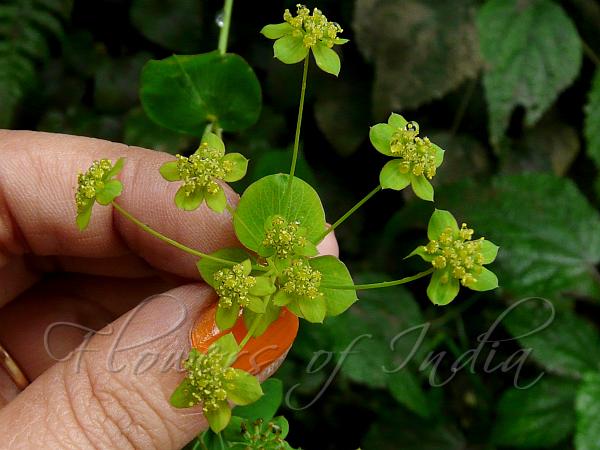|
| Himalayan Thorowax |
|

|

| File size | 518695 |
| Original date | 7/27/14 3:44 PM |
| Resolution | 2560 x 1920 |
| Flash | Flash did not fire, auto |
| Focal length | 4.6mm |
| Exposure time | 1/100s |
| Aperture | 4.0 |
| Focus Distance | |
| Metering Mode | Spot |
| Camera make | Panasonic |
| Camera model | DMC-FZ18 |
| Sensor type | OneChipColorArea |
|
|
|
Photo: |
Botanical name: Bupleurum candollei Family: Apiaceae (Carrot family)
Himalayan Thorowax is a medicinal plant whose Chinese cousin is popular in
Chinese medicine. It is an erect perennial herb which grow upto 1 m high.
Oblong-ovate stem leaves are almost without stalk, and have an smooth margin.
Tiny flowers appear in compound umbels 2.5-4 cm across, typical of the carrot
family. The flowers themselves are very small, and
appear in a bunch of 10-15 in secondary umbels 8-12 mm across, enclosed in
unequal bracts which looks like leaves. The flowers petals are either pale
yellow or dark purple. Himalayan Thorowax is found in mixed forests on shady
slopes, open forests, mountain slopes, grassy places, at altitudes 2400-4000 m.
This genus is very confusing and species are highly variable.
Medicinal uses: The roots of several species of Bupleurum are famous for their use as the
traditional Chinese medicine “chai hu” for treatment of coughs, fevers, and
influenza. Almost all of the species are recorded in the literature as
regional substitutes for “chai hu” or for other local medicinal purposes.
However, caution should be applied as a very few species are toxic (e.g., B.
longiradiatum) and can result in “toxic strike” if misused as such
substitutes.
The roots of several species of Bupleurum are famous for their use as the
traditional Chinese medicine “chai hu” for treatment of coughs, fevers, and
influenza. Almost all of the species are recorded in the literature as
regional substitutes for “chai hu” or for other local medicinal purposes.
However, caution should be applied as a very few species are toxic (e.g., B.
longiradiatum) and can result in “toxic strike” if misused as such
substitutes.
Medicinal uses:
 The roots of several species of Bupleurum are famous for their use as the
traditional Chinese medicine “chai hu” for treatment of coughs, fevers, and
influenza. Almost all of the species are recorded in the literature as
regional substitutes for “chai hu” or for other local medicinal purposes.
However, caution should be applied as a very few species are toxic (e.g., B.
longiradiatum) and can result in “toxic strike” if misused as such
substitutes.
The roots of several species of Bupleurum are famous for their use as the
traditional Chinese medicine “chai hu” for treatment of coughs, fevers, and
influenza. Almost all of the species are recorded in the literature as
regional substitutes for “chai hu” or for other local medicinal purposes.
However, caution should be applied as a very few species are toxic (e.g., B.
longiradiatum) and can result in “toxic strike” if misused as such
substitutes. | Identification credit: Gurcharan Singh | Photographed in Narkanda, Himachal Pradesh & Chakrata, Uttarakhand. |
• Is this flower misidentified? If yes,